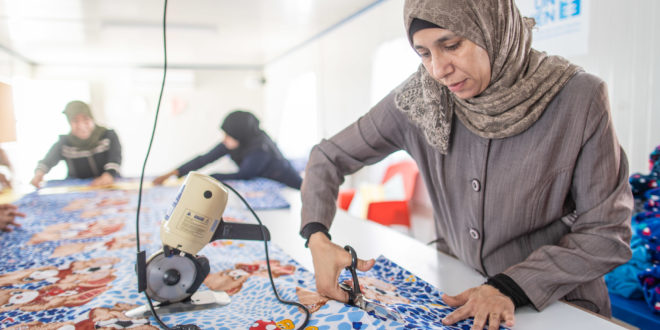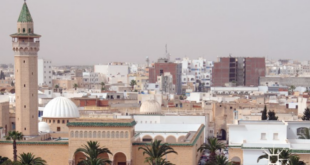Issue 30, summer/fall 2020
https://doi.org/10.70090/SKEC29DI
Abstract:
This article tackles the complex struggles faced by Arab women, including multiple layers of invisibility, marginalization and inequality,[1] all of which have significantly worsened during the COVID-19 pandemic. This examination includes a special focus on how and why the “digital divide,” defined as the gap between the technological haves and have-nots, has been a major contributing factor to this accelerating inequality. [2] It proposes adopting an alternative ‘digital socialism’ model and a comprehensive, gender-centered leadership approach to address this situation.
Introduction:
When the COVID-19 pandemic swept the world in 2020, it impacted various aspects of life significantly, including education, employment, travel, health services, the economy, and even media consumption, and information-seeking and sharing patterns. Less developed regions suffered even greater problems, as their existing challenges were exacerbated dramatically. For example, amid the expanding economic downturn fueled by the pandemic, fragile states in the Arab world appear to be plagued with an additional socioeconomic virus. One example is Lebanon, which spiraled to the brink of total collapse due to its severe domestic, economic, and political crises, many of which were exacerbated by COVID-19.[3] Another example is Egypt, which is also reeling from the economic impact of the pandemic, coupled with the fall in oil prices and declining tourism.[4]
This has particularly dangerous implications for the region’s most vulnerable groups, such as women, the poor, migrant and non-traditional workers, refugees, and displaced persons.[5] Indeed, the IMF has predicted an overall 7 percent drop in real GDP in Arab economies, as well as a 14 percent fall in remittances throughout the region, with myriad political, economic, and social effects, including exacerbating gender disparities.[6]
Moreover, the overwhelming explosion of information which accompanied this pandemic resulted, in some cases, in an information overload, or what came to be known as an “infodemic,” a term coined by the World Health Organization (WHO) in reference to the wave of misinformation, disinformation, and rumors, which paralleled the spread of COVID-19.[7]
However, another parallel—yet contradictory—threat, which could be referred to as an ‘info-deficiency,’ manifests itself as the shortage of important, basic information, also accompanied the spread of this pandemic, with especially dire consequences for the most vulnerable and marginalized groups, including Arab women. This ‘info-deficiency’ also intersects with an underlying systemic divide between the women of the Arab world in terms of access, context, training, and ownership to the systems of information in which they are participants, leading to further inequalities.
Arab Women’s Challenges, Invisibilities, and Struggles
Women across the Arab world suffer from a series of intersecting invisibilities, with many elements of their economic, social, and political contributions to the societies in which they live remaining uncounted, undocumented, or disregarded.[8] Similarly, disparities between access to information and education by gender mean that women in the Arab world are often ill positioned to participate in society more broadly. In a region with pockets of high illiteracy rates, women, especially in rural and remote areas, suffer from higher illiteracy compared to men, while at the other end of the spectrum, some highly educated women in the region remain deeply disenfranchised from the job market and information economy.[9] Arab women also suffer from stagnant social traditions, stemming from a deeply-rooted patriarchal culture. This leads to social practices which disadvantage women, such as early marriage, decreased formal education access, and limited employment.[10]
Overall, Arab women suffer from three layers of invisibility, which obscure their complex identities and lived realities, namely: media misrepresentations, marginalization in academic literature, and marginalization in the socioeconomic sphere.[11]
Therefore, when the Arab Spring erupted in 2011, Arab women were engaged in a dual struggle to liberate their countries from autocracy, while also liberating themselves from marginalization, through an attempt to secure equity in the political, social, economic, and legal spheres.[12]
In other words, while Arab men engaged in one struggle to end political injustice, Arab women engaged in two parallel struggles to end both political and social injustice.[13]
The Devastating Socio-Economic Impact of COVID-19 on Arab Women:
As families around the world cope with the impact of health care challenges, loss of childcare, and the re-navigation of schooling and family life alongside job loss and family sickness; women in less developed countries grapple with these challenges in more significant ways, socially and economically. In many ways, the COVID-19 crisis magnified previously existing inequalities for Arab women, which intersect with the accelerating risks of capitalism, a system of governance and profit which prioritizes economic expansion and profit at the expense of collective health and well-being.[14]
Around fifteen percent of households across the Arab world suffer from domestic violence, according to the Arab Barometer’s survey of 2018-2019. Of these domestic violence incidents female victims accounted for 82 percent in Lebanon, 72 percent in Egypt, and 71 percent in Morocco (with the remaining victims reported as male).[15] Increased instances of domestic abuse have been reported during the pandemic, especially with families quarantining together for extended periods of time, which illustrates that stay-at-home orders are often implicitly insensitive to the needs of women living in abusive households.[16]
The already overstretched health care systems in a number of Arab countries have suffered even more from loss of resources during the pandemic.[17] For example, decimated healthcare institutions in conflict-torn countries like Syria, Libya, and Yemen, all of which suffer from severe humanitarian crises, offered less access to health and reproductive services, especially to vulnerable populations like women.[18]
Arab women are overrepresented in the healthcare sector, but not in leadership positions, rather mostly as nurses or nurse assistants. For example, 44 percent of Jordan’s women work in the healthcare sector, mostly as nurses, while 80 percent of Lebanon’s nurses are women. This increases their risk of infection amid the pandemic.[19]
Moreover, Arab women tend to disproportionately play the role of the caretakers, who look after the sick, the elderly, children, and the disabled. This places high demands on their energy, time and resources, while denying them the opportunity to seek formal employment or to advance themselves professionally. This more pressing during the pandemic, adding the danger of exposure to infection, while allowing them less opportunity to seek medical services.[20]
Other crisis-related challenges ranged from school closures to spikes in child marriage and teen pregnancy, especially since many girls may be unlikely to return to school when the pandemic subsides.[21] Many of these threats are clearly interrelated. When girls do not return to school, they are more likely to end up getting married early, and, therefore, becoming mothers at a younger age, and giving birth to more children. This also limits their chances to attain formal employment and to earn sustainable wages.
Since a larger proportion of Arab women are essential workers, whether in agriculture, manufacturing, or small enterprises, this leads to less stable wage payment, higher risk of infection, and less job stability. Women were hit harder by unemployment and the economic fallout resulting from the pandemic.[22] Another challenge is the loss of male supporters and breadwinners, through death, illness, or unemployment, which increases their economic and psychological burdens.
These factors, coupled with geopolitical struggles and conflicts in the region, rendered women in less advantaged and more vulnerable situations, such as becoming unemployed refugees, undocumented migrant workers, or underpaid, informal laborers. This, in turn, poses other risks and challenges, which exacerbated in the midst of the pandemic. Overall, the resulting picture is that of worsening conditions and increased challenges, which has added to Arab women’s poverty, oppression, marginalization, and invisibility.
The Impact of the Digital Divide on Arab Women amid COVID-19: The Cause-Effect Cycle
Even as economists and policymakers in Europe and the U.S. have cautiously projected the potential for expanded economic and job growth in the digital sphere, with many jobs, schools, and government operations moving more permanently online, some called for closer attention to the way that this shift may accelerate existing gaps in technological access.[23]
This has important implications for the economic status of Arab women. Historically, some Arab women engaged in political, social, legal and communication revolutions in the midst of the Arab uprisings through their engagement in the phenomenon of “cyber-feminism”[24], or the reliance on new technologies to amplify their gender-specific messages by opening a window to see the world and to be seen by the world simultaneously this phenomenon did not trickle down equally to all Arab women.[25] It remained restricted to a certain category of younger, urban, more educated, more economically advantaged women, while excluding the majority of Arab women, due to educational, cultural, social, economic, and infrastructural constraints, despite the grassroots nature of the Arab Spring uprisings.
This digital gap between the technological haves and have-nots widened even more during the COVID-19 pandemic, in a number of striking ways, and had profound effects on Arab women’s lives. For example, less income, less education, and less infrastructure, meant less access to technology, which, in turn, meant less access to necessary health information, related to both testing and treatment, most of which is now available online. This poses health risks, not just for the women themselves, but also for their families, since women are the primary caretakers in most cases. Ironically, while Arab women are more vulnerable to infection, they not only have less access to correct medical information, which is mostly available online, they also have less potential to visit medical facilities, evaluate medical services, or pay for medical care alone, since many of these services are increasingly digitalized.
As education shifts to mostly online platforms, the element of “digital literacy” clearly privileges some people over others.[26] Moreover, those who have less access to high speed internet, do not have the needed resources and infrastructure, let alone the required digital literacy skills, are less likely to benefit from this type of education. This includes those who are mostly in rural areas, those with disabilities, and the less economically and socially privileged, as in the case of many Arab women.
Education being the door to employment also means that many Arab women, by being left out from the increasingly online-based education, will be more likely left out from the realm of formal employment as well. This means that they will mostly stay trapped in informal, less paying—or even non-paying—labor, which will also keep them trapped in their less advantaged socio-economic status, while simultaneously adding to their obscurity, invisibility, and health risks.[27]
Moreover, this also means that they don’t have the luxury to work from home, which is restricted to technologically-savvy, economically-privileged, urban-based, white-collar professionals. This, in turn, puts them at higher risk of illness, job instability, or both.
The lack of “digital literacy” also makes it difficult for many Arab women to seek resources which could help them address their pressing challenges, such as domestic violence, for example, since a lot of this information is digitally-based. It also makes it difficult for them to separate fact from fiction and truth form lies in the midst of the ‘infodemic’ of misinformation, which accompanied COVID-19.
Ironically, the factors which contribute to widening the “digital divide” are the educational gap, the urban vs. rural divide, the income gap, and generational differences, but the “digital divide” itself exacerbates many of these discrepancies, resulting in an interconnected, vicious cycle of cause and effect, which perpetually disadvantages Arab women.
Concluding Remarks: The Need for Digital Socialism and Gender-Centered Leadership
The current status of Arab women amid this pandemic is that of overlapping layers of oppression and disadvantage, which have been exacerbated by women’s escalating digital divide and increasing ‘info-deficiency’.
In 2011, the initial moment of “techno-euphoria”, which was characterized by strong confidence in the democratizing potential of social media, was replaced by a new form of “digital authoritarianism,” which increased the power of governments at the expense of the people. Similarly, the initial moment of “techno-egalitarianism,” which was characterized by strong confidence in the equalizing potential of social media, was replaced by a new form of “digital privilege,” which increased the power of the elites at the expense of marginalized groups.[28]
Addressing this situation necessitates replacing this system of “digital capitalism,” with an alternative model of “digital socialism,” in which a more open-source model of information sharing would revolve around the public interest, rather than profit.[29] To ensure the success of this new model, governments would be obligated to subsidize public interest-based developments in technology, and social and information networks would be built on the basis of consensus and necessity.[30]
Additionally, rectifying this situation necessitates tackling the interconnected structures of injustice and the practices of discrimination impacting Arab women and limiting their potential for growth and advancement, both before and during the COVID-19 pandemic.
This requires adopting a comprehensive gender-centered and culturally-sensitive approach, which takes into account the complexity of Arab women’s lived realities, identities, and struggles, when designing a recovery plan for a post-COVID-19 Arab world.
To date, there have been only few gender-centered public policy actions and interventions, which focused specifically on supporting Arab women in facing the socio-economic repercussions of the COVID-19 crisis, such as targeted cash transfers to women in Egypt, exceptional paid leave for women employees in the Palestinian territories and Iraq, and some governments providing assistance to women entrepreneurs, with the support of international organizations, often through online training programs.[31]
However, such initiatives remain few and far between. These efforts need to become more systematic and must make the argument that women are key contributors to the economy and are a major asset on the path towards economic recovery. They also need to expand to come up with innovative solutions to address gender-specific challenges and constraints, through prioritizing the centrality of women’s leadership and their integration in the decision-making process. The proverb “If you are not at the table, you will be on the menu” is certainly applicable to Arab women, whose absence from decision-making processes contributed to furthering their underprivileged status.
The radical re-envisioning of structures of labor, resources, and security that will necessarily be part of a post-COVID-19 reality in the Arab world presents a chance to “change prevailing gender norms” in the Arab world, as well as to draw closer attention to the ways in which women’s labor is a vital part of Arab economies, and should be recognized as such.[32]
However, any solutions must also be locally-rooted, using a grassroots approach, avoiding orientalist and colonialist development approaches to development and gender equality.[33] Then, and only then, can the road be charted ahead for Arab women’s empowerment and equity, amid and beyond the COVID-19 crisis.
[1]. Katerina Delacoura. 2019 “Women and Gender in the Middle East and North Africa: Mapping the Field and Addressing Policy Dilemmas at the Post-2011 Juncture.” MENARA Project, No. 3, March, http://www.menaraproject.eu/wp-content/uploads/2019/03/menara_fr_3-1.pdf
[2]. Alexander JAM van Deursen and Jan AGM van Dijk. 2019. “The First-Level Digital Divide Shifts from Inequalities in Physical Access to Inequalities in Material Access,” New Media & Society 21, no. 2 (February): 354-355. https://doi.org/10.1177/1461444818797082
[3]. Ben Hubbard, 2020. “Lebanon’s Economic Crisis Explodes, Threatening Decades of Prosperity,” New York Times, May 10, https://www.nytimes.com/2020/05/10/world/middleeast/lebanon-economic-crisis.html
[4]. Jared Malsin, 2020. “Egypt Gets 2.77 Billion IMF Loan as Coronavirus Hurts Economy,” Wall Street Journal, May 11, https://www.wsj.com/articles/egypt-gets-2-77-billion-imf-loan-as-coronavirus-hurts-economy-11589219450
[5]. “COVID-19 and the Middle East,” Middle East Insights (blog), Middle East Institute, March 18, 2020, https://www.mei.edu/blog/COVID-19-and-middle-east
[6]. “COVID-19 poses formidable threat for fragile states in the Middle East and North Africa,” International Monetary Fund, IMF Country Focus, May 13, 2020, https://www.imf.org/en/News/Articles/2020/05/13/na051320-COVID-19-poses-formidable-threat-for-fragile-states-in-the-middle-east-and-north-africa
[7]. Zoe Thomas, 2020. “WHO says fake coronavirus claims causing 'infodemic,” BBC, February 13, https://www.bbc.com/news/technology-51497800
[8]. Youmna Cham, Jad Jaber, and Abir El Danaf, 2019, “The indigenous challenges facing Arab women in the Middle East and North Africa economies,” London School of Economics International Development (blog), September 6, https://blogs.lse.ac.uk/internationaldevelopment/2019/09/06/the-indigenous-challenges-facing-arab-women-in-the-middle-east-and-north-africa-economies/
[9]. Farzaneh Roudi-Fahimi and Valentine Moghadam, 2003, “Empowering Women, Developing Society: Female Education in the Middle East and North Africa,” Population Reference Bureau, November 3, https://www.prb.org/empoweringwomendevelopingsocietyfemaleeducationinthemiddleeastandnorthafrica/
[10]. Sahar Khamis, 2004. “Multiple literacies, multiple identities: Egyptian rural women's readings of televised literacy campaigns,” in Women and media in the Middle East: Power through self-expression, ed. Naomi Sakr (London: I.B. Tauris): 89 –108.
[11]. Ibid.
[12]. Sahar Khamis and Amel Mili, eds. 2018. Arab Women's Activism and Socio-Political Transformation: Unfinished Gendered Revolutions (New York: Palgrave Macmillan, 2018).
[13]. Amal Mohammed Al-Malki, David Kaufer, Suguru Ishizaki, and Kira Dreher, 2012. Arab Women in Arab News: Old Stereotypes and New Media, (Doha: Bloomsbury Qatar Foundation Publishing).
[14]. Jonathan Portes, 2020 “Don't believe the myth that we must sacrifice lives to save the economy,” The Guardian, March 25, https://www.theguardian.com/commentisfree/2020/mar/25/there-is-no-trade-off-between-the-economy-and-health
[15]. Aseel Alayli, 2020, “Domestic violence and Arab women’s false choices during COVID-19,” Daraj, June 1, https://daraj.com/en/47578/
[16]. Caroline Bettinger-Lopez, 2020, “A Double Pandemic: Domestic Violence in the Age of COVID-19,” Council on Foreign Relations, May 13, https://www.cfr.org/in-brief/double-pandemic-domestic-violence-age-COVID-19
[17]. Erin Hayes, 2020, “The Impact of COVID-19 on MENA’s Already Challenged Healthcare Systems,” Arab Barometer, July 9. https://www.arabbarometer.org/2020/07/low-capacity-and-trust-the-impact-of-COVID-19-on-menas-already-challenged-healthcare-systems/?ct=t(EMAIL_CAMPAIGN_7_10_2020_16_5)&mc_cid=45bbd7f8cc&mc_eid=5a45f8aaf0[18]. Eric Goldstein and Amy Braunschweiger, 2020, “When Health Care Is Decimated By War: COVID-19 in the Middle East and North Africa,” Human Rights Watch, April 16, https://www.hrw.org/news/2020/04/16/when-health-care-decimated-war-covid-19-middle-east-and-north-africa
[19]. Ibid.[20]. Mayyada Abu Jaber, 2020, “Recognizing women’s important role in Jordan’s COVID-19 response,” Education Plus Development (blog), Brookings Institution, April 29, https://www.brookings.edu/blog/education-plus-development/2020/04/29/recognizing-womens-important.-role-in-jordans-COVID-19-response
[21]. Sharmishtha Nanda, 2020, “Coronavirus Fallout: Impact of School Closures on Girls in India,” Ms. Magazine, April 14, 2020, https://msmagazine.com/2020/04/14/coronavirus-fallout-impact-of-school-closures-on-girls-in-india/?emci=d2edc4fc-5f89-ea11-86e9-00155d03b5dd&emdi=d911700b-ca8e-ea11-86e9-00155d03b5dd&ceid=3730638
[22]. “COVID-19 crisis response in MENA countries,” Policy Responses, Organization for Economic Co-operation and Development (OECD), June 9, 2020, http://www.oecd.org/coronavirus/policy-responses/COVID-19-crisis-response-in-mena-countries-4b366396/[23]. Douglas Broom, 2020, “Coronavirus has exposed the digital divide like never before,” World Economic Forum, April 22, https://www.weforum.org/agenda/2020/04/coronavirus-covid-19-pandemic-digital-divide-internet-data-broadband-mobbile
[24]. Courtney Radsch and Sahar Khamis, 2013, “In their own voice: Technologically mediated empowerment and transformation among young Arab women,” Feminist Media Studies 13, no. 5: 881-890.
[25]. Nada Alwadi and Sahar Khamis, 2018 “Voices shouting for reform: The remaining battles for Bahraini Women,” in Arab Women’s Activism and Socio-Political Transformation: Unfinished Gendered Revolutions, eds. Sahar Khamis and Amel Mili (New York: Palgrave MacMillan), 53-71.
[26]. Kira Allmann, 2020, “Covid-19 is increasing digital inequality: We need human connectivity to close the digital divide,” The Oxfordshire Digital Inclusion Project, April 14, https://www.law.ox.ac.uk/research-and-subject-groups/oxfordshire-digital-inclusion-project/blog/2020/04/COVID-19-increasing
[27]. Maha El-Swais, 2016 “Despite high education levels, Arab women still don’t have jobs,” Arab Voices, World Bank Blogs, March 9, https://blogs.worldbank.org/arabvoices/despite-high-education-levels-arab-women-still-don-t-have-jobs
[28]. Sahar Khamis, 2019, “The Online Public Sphere in the Gulf: Contestation, Creativity, and Change,” in Review of Middle East Studies 53, no. 2 (December): 190–99, https://doi.org/10.1017/rms.2019.41
[29]. John Asimakopoulos, Anthony J. Nocella, and Shannon Deric, 2012, The Accumulation of Freedom: Writings on Anarchist Economics (Oakland: AK Press).
[30]. Ibid.
[31]. OECD, 2020 “Covid-19 Crisis Response.”
[32]. Ibid.
[33]. Haneen Shafeeq Ghabra, 2018, Muslim Women and White Femininity: Reenactment and Resistance (New York: Peter Lang).
 Arab Media & Society The Arab Media Hub
Arab Media & Society The Arab Media Hub





